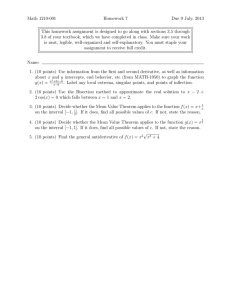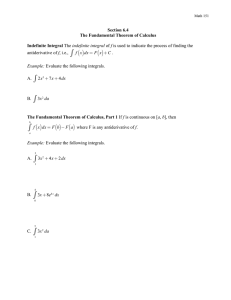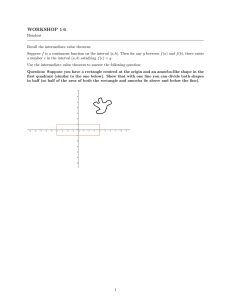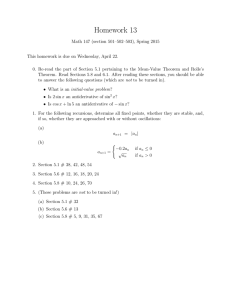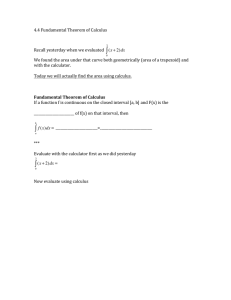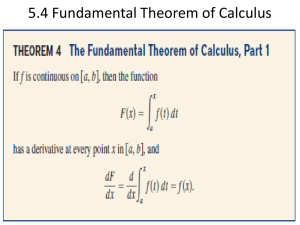Fundamental Theorem of Calculus Lecture Notes
advertisement
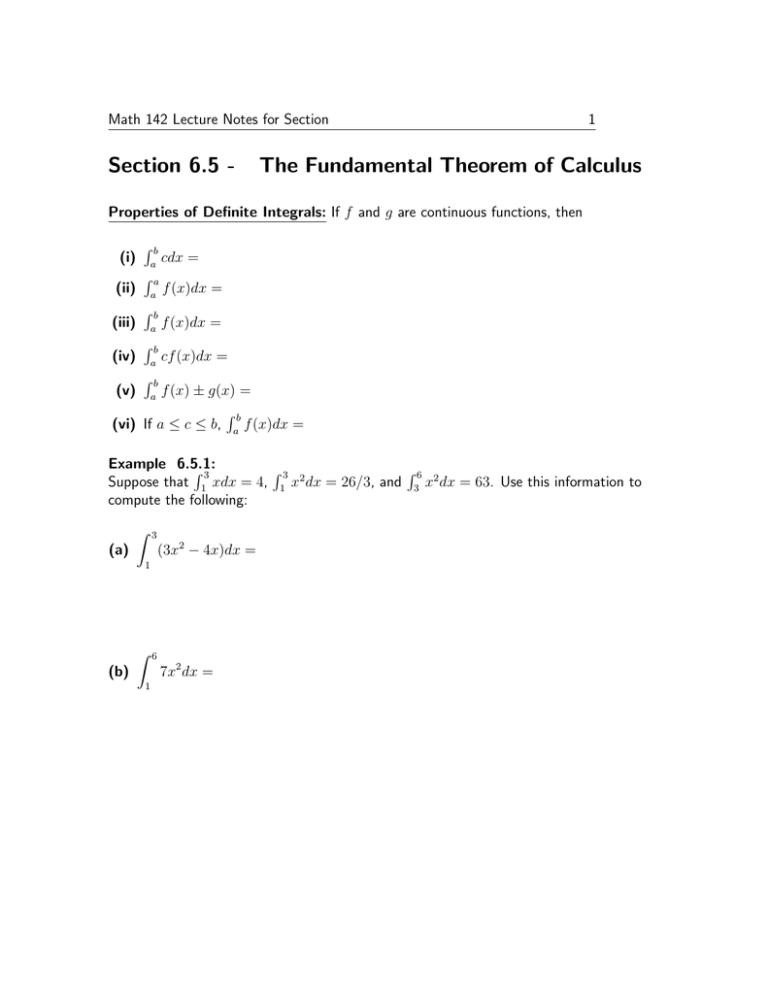
Math 142 Lecture Notes for Section Section 6.5 - 1 The Fundamental Theorem of Calculus Properties of Definite Integrals: If f and g are continuous functions, then (i) Rb (ii) Ra (iii) Rb (iv) Rb a a a a cdx = f (x)dx = f (x)dx = cf (x)dx = Rb f (x) ± g(x) = Rb (vi) If a ≤ c ≤ b, a f (x)dx = (v) a Example 6.5.1: R3 R3 R6 Suppose that 1 xdx = 4, 1 x2 dx = 26/3, and 3 x2 dx = 63. Use this information to compute the following: 3 Z (3x2 − 4x)dx = (a) 1 Z (b) 1 6 7x2 dx = Math 142 Lecture Notes for Section 2 Fundamental Theorem of Calculus - Part 2: Suppose f is continuous on [a, b]. Then it holds that Z b dF f (x)dx = F (b) − F (a), where F is any antiderivative of f, that is = f. dx a Example 6.5.2: Evaluate the following: 3 Z (x2 + 3)dx = (a) −2 Z 4 (ex + 3x)dx = (b) 1 Z (c) 2 (3x − 5)3 dx = 0 Net Change Theorem: The integral of a rate of change is the net change of the original function: Z b df dx = f (x)|ba = f (b) − f (a). dx a Math 142 Lecture Notes for Section Example 6.5.3: A rabbit population starts with 250 and increases at a rate of does Z 10 db 250 + dt dt 0 3 db dt bees per week. What represent? Example 6.5.4: A flood starts at 2000 square feet √ of a parking lot at time t = 0 and the water drains dr from the lot at a rate of dt = 3 t per second. How much water is drained during the second minute? Example 6.5.5: A ball is fired out of a cannon at an initial velocity of 15m/s, with a rate of acceleration measured by e−t/10 . How do we compute the velocity of the ball after 6 seconds? Math 142 Lecture Notes for Section 4 Fundamental Theorem of Calculus - Part 1: Suppose f is continuous on [a, b]. If Rb dg = f (x) for a ≤ x ≤ b. g(x) = a f (t)dt, then g is the antiderivative of f , that is dx This can also be written as Z x d f (t)dt = f (x). dx a Example 6.5.6: Find the derivative of the following functions: (a) g(x) = Rx (b) k(x) = Rx (c) h(x) = R x2 1 0 3 t2 dt. 2 et−t dt. et dt. Question: How do you average finitely many values? Math 142 Lecture Notes for Section 5 Question: How do you average infinitely many values? Definition 6.5.7: The average value of a continuous function f on the interval [a, b] is given by Z b 1 f (x)dx. b−a a Example 6.5.8: Find the average value of the following functions on the given interval. (a) f (x) = 3 on [1, 4]. (b) f (x) = 8x3 + x on [2, 6]. Example 6.5.9: Given the supply function p = 20(e−.25x − 1), find the average price over the interval [20, 40]. Section 6.5 Suggested Homework: 1-51 (odd), 55-63(odd)

